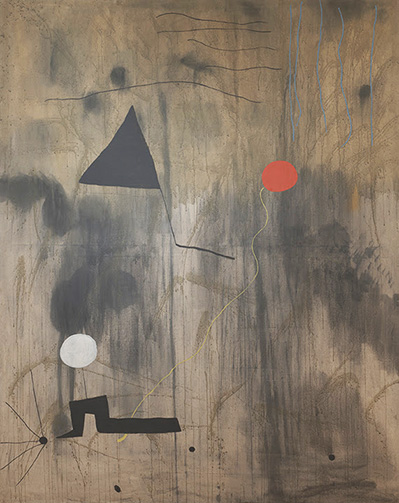CulBeat Express
2018.11.14 22:56
MoMA 호안 미로(Joan Miró) 특별전(2/24-7/6)
조회 수 723 댓글 0
MoMA ANNOUNCES FOCUSED EXHIBITION ON JOAN MIRÓ AND HIS MASTERPIECE THE BIRTH OF THE WORLD, FEATURING WORKS FROM THE MUSEUM’S EXCEPTIONAL MIRÓ COLLECTION

NEW YORK, November 14, 2018—The Museum of Modern Art presents Joan Miró: Birth of
the World, an exhibition that explores the development of Miró’s pictorial universe, with
particular emphasis on his intense engagement with poetry, the creative process, material
experimentation, and the seen and unseen world. This focused exhibition, drawn from
MoMA’s unrivalled Miró collection and augmented by several key loans, situates his
monumental painting, The Birth of the World (1925), in relation to other key works by the
artist, which are rarely shown together. On view from February 24 through July 6, 2019, the
exhibition includes approximately 60 paintings, works on paper, prints, illustrated books,
collages, and objects primarily made between 1920, the year of Miró’s first catalytic trip to
Paris, and the early 1950s, when his unique visual language gained international acclaim. Joan
Miró: Birth of the World is organized by Anne Umland, The Blanchette Hooker Rockefeller
Senior Curator, Department of Painting and Sculpture.
The Museum of Modern Art’s collection of Miró’s works constitutes one of the finest and most
comprehensive in the world. In 1941, MoMA organized the first major museum retrospective
of Miró’s work, followed by others in 1959 and 1993, the centennial of the artist’s birth. The
Museum has also presented focused exhibitions, most recently Joan Miró: Painting and AntiPainting
1927–1937 (2008), which explored a single, transformative decade in Miró’s long
career. The present exhibition extends the Museum’s commitment to Miró by offering for
examination and reassessment an in-depth presentation of his works from the collection.
The Museum acquired Miró’s The Birth of the World in 1972, in part as a gift from the artist.
Since then, it has been on regular display in the Museum’s collection galleries, and is widely
acknowledged as one of the artist’s greatest works. Miró covered the ground of his oversized
canvas by applying paint in an astonishing variety of ways that recall poetic chance
procedures. He then added a series of pictographic signs that seem less painted than drawn,
transforming the broken syntax, constellated space, and dreamlike imagery of avant-garde
poetry into a radiantly imaginative and highly experimental form of painting.
Organized chronologically, the exhibition begins with Miró’s Portrait of Enric Cristòfol Ricart
(1917), displayed at the Museum for the first time since 2000. This painting-cum-collage
announces Miró’s ambition to be an “International Catalan,” with its local subject (Miró’s
Barcelona studio mate, E. C. Ricart), bright, French Fauve–inspired palette, and pasted-in
Japanese print. A few years later Miró experienced what he once described as the “jolt” of his
first trip to Paris in 1920. There he became close friends with a group of young avant-garde
poets and painters who had a decisive impact on his work.
With The Hunter (Catalan Landscape) (1923–24), on view in the exhibition, Miró went, as he
later said, “beyond painting” to create a visionary, fantastical landscape filled with schematic
symbols and signs. The Surrealist poet André Breton acquired this work in 1925. During the
summer of that same year, Miró—buoyed by the encouragement of Breton and other
Surrealists—painted The Birth of the World, the exhibition’s focal point. This work, long
celebrated as a precursor of post–World War II gestural abstraction in Asia, Europe, and the
United States, demonstrates how, in Miró’s pictorial universe, visionary and cosmic elements
are inextricably intertwined with the earthly and mundane.
The exhibition continues with works from the 1920s and 1930s created after The Birth of the
World, including what are often referred to as Miró’s “savage paintings,” which respond to the
rising political tensions in Spain in the years leading up to the Spanish Civil War. One such
work included in the exhibition, Rope and People, I (1935), combines a crude hank of coiled
rope with bright colors and grotesque figuration to produce an aggressive physicality.
Miró was forced into exile in France late in 1936 due to his Republican sympathies; at the
onset of World War II he moved his family to Varengeville, on the coast of Normandy, where he
thought they would be safe. There, during a time of isolation and great personal anxiety, he
began a series of small gouache and oil washes on paper collectively known as the
Constellations. These works have a sense of immensity, despite their small size. They include
The Escape Ladder (1940) and The Beautiful Bird Revealing the Unknown to a Pair of Lovers
(1941), which are featured together in the exhibition.
By the end of the War, Miró had established the magical, pictographic imagery of wiry figures,
birds, stars, and sexual symbols for which he was to become renowned. A testament to his
growing international recognition, from the late 1940s on, he was involved in a number of
public commissions, including Mural Painting (1950–51), which, commissioned for a Harvard
University dining room, measures nearly 20 feet in length. The exhibition closes with this
frieze of calligraphic figures that float, suspended, against the veiled, atmospheric browns
and blues of the ground.






